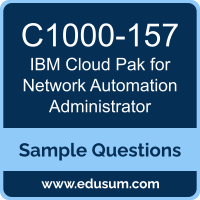01. What is the result of issuing the following command?
oc get routes -l component=ibm-nginx
a) s3Credentials
b) s3_endpointURL
c) # of instances
d) value for <Cluster_url>
02. Which two Lifecycle Model steps represent positive transitions?
a) Delete
b) Restart
c) Install
d) Configure
e) Uninstall
03. How does an assembly get into the broken state?
a) An integrity check designates an assembly or resource as broken when an error indicates that it might not be successful with all its applications or tasks.
b) Negative transitions move assemblies into a broken state.
c) There is no broken state for an assembly.
d) Feedback on the status of deployed resources is available to the operator, who can manually intervene when necessary and put the whole assembly into the broken state.
04. Which statement is true about removing a shared infrastructure key?
a) The HTTP method of the request is POST.
b) Required parameters at request are id and name.
c) If execution is successful, the status code 204 is returned.
d) It cannot be removed by specifying the name position of the shared infrastructure key.
05. What are two ways to add permissions to a plug-in after it is installed and enabled on Site Planner?
a) The Django framework discovers models in custom plug-in automatically.
b) Permissions need to be defined in the configuration.py file of the plug-in.
c) Permissions need to be defined in the configuration.py file of Site Planner.
d) A plug-in does not need permissions to be exposed to it and has administrator privileges by default.
e) Models that are added by the plug-in are automatically included in the default SPAdmin, SPEditor, and SPView roles. The Plug-in is assigned their permissions or privileges from these roles.
06. Which statement about Lifecycle Manager Control tool commands is true?
a) lmctl project test is used to execute the behavior tests of the project.
b) lmctl project create is used to build distributable package for a project.
c) lmctl project pull is used to pull images from the container image registry.
d) lmctl project inject is used to push a previously built package to a Cloud Pak for Network Automation orchestration environment.
07. Which statement is true about the Cloud Pak for Network Automation (CP4NA) installation prerequisites?
a) The catalog sources can only be added with the OpenShift CLI.
b) An OpenShift configmap must be created for custom Site Planner plug-ins.
c) OpenShift Container Platform 4.10 or higher is required for CP4NA installation.
d) IBM Operator Catalog and IBM Common Services must be added before Orchestration Manager is installed.
08. The resources of the Cloud Pak for Network Automation orchestration component are protected by an authentication layer. What is the minimum requirement needed to gain access to these protected resources?
a) System password
b) Valid Bearer Token
c) Valid client ID and secret
d) Administrator authentication
09. When planning a Cloud Pak for Network Automation installation, which statement about security is true?
a) OpenSSL is required for storage encryption.
b) OpenSSL is only required for installations where the cluster is not connected to the internet.
c) OpenSSL is required for FIPS-140 compliance to encrypt connections between the components of the cloud pak.
d) OpenSSL is required for hybrid cloud installations, where the cluster is distributed between local and cloud based environments.
10. Which task is required to make a resource driver available?
a) Create LMCTL project files and scripts for the resource drivers to be used in each lifecycle.
b) Onboard the resource drivers into the Cloud Pak for Network Automation environment using the cloudctl command.
c) Install resource drivers in the Cloud Pak for Network Automation environment in the manner specified for each resource driver.
d) Push LMCTL project files and scripts for the resource drivers to be used in each lifecycle to the Cloud Pak for Network Automation environment.
 The purpose of this Sample Question Set is to provide you with information about the IBM Cloud Pak for Network Automation v2.4 Administrator exam. These sample questions will make you very familiar with both the type and the difficulty level of the questions on the C1000-157 certification test. To get familiar with real exam environment, we suggest you try our Sample IBM Cloud Pak for Network Automation Administrator Certification Practice Exam. This sample practice exam gives you the feeling of reality and is a clue to the questions asked in the actual IBM Certified Administrator - Cloud Pak for Network Automation v2.4 certification exam.
The purpose of this Sample Question Set is to provide you with information about the IBM Cloud Pak for Network Automation v2.4 Administrator exam. These sample questions will make you very familiar with both the type and the difficulty level of the questions on the C1000-157 certification test. To get familiar with real exam environment, we suggest you try our Sample IBM Cloud Pak for Network Automation Administrator Certification Practice Exam. This sample practice exam gives you the feeling of reality and is a clue to the questions asked in the actual IBM Certified Administrator - Cloud Pak for Network Automation v2.4 certification exam.